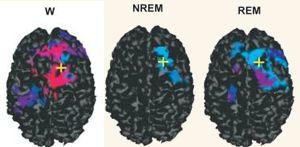Monday, 13 June 2016
Conscious Awareness and Integration of Brain Activity: They Go Together

Sometimes the complementarity between certain scientific experiments may not actually prove anything but still points in a fairly obvious direction. And that is the case with a study that was brought to my attention by a reader of this blog (thanks, Pascal R.!) after I published two posts recently on studies of the type of neuronal activity associated with conscious awareness. Before I summarize the study that Pascal told me about, let me remind you about the findings of the two other studies.
In the first study, by Douglass Godwin and his colleagues, subjects were shown an image very briefly and then asked whether they had consciously perceived it. Using functional MRI, the researchers found that among those subjects who said that they had perceived the image, there was a sudden reduction in the modularity of brain function and a corresponding increase in large-scale neuronal communication throughout the brain’s circuits at the time that the image was shown.
In the second study, which was conducted by Habib Benali and his team and in which they too used fMRI to measure functional connectivity among various regions of the brain, the researchers found that when subjects fell into deep sleep and lost consciousness, their brain activity became more fragmented and modular.
The third study, published by Giulio Tononi and his team in the journal Cognitive Neuroscience in 2010, also suggests that there is an integration of brain activity into extensive networks in the case of conscious phenomena and a fragmentation of brain activity into smaller modules in the case of unconscious phenomena. Tononi argues for an “integrated information theory” of consciousness that is completely consistent with the findings of Godwin and Benali; according to this theory, consciousness is less a matter of the firing rate of action potentials, or of the synchronization of neuronal activity at certain frequencies, or of sensory inputs themselves, but rather of the brain’s ability, at a given moment, to integrate a great deal of information through large-scale functional connectivity. As Tononi’s article states, this functional connectivity is simply the ability of one group of neurons to affect the activity of another group of neurons elsewhere in the network.
In their experiment, Tononi and his colleagues used a different method from the two other studies, applying transcranial magnetic stimulation (TMS) to an area of the brain and using an electroencephalograph (EEG) to record the brain activity induced by this stimulus. The researchers compared the brain’s responses to this stimulus in three different states: waking (the image labelled “W” above), non-REM (deep) sleep (NREM), and REM sleep (dreaming).
And Tononi’s findings pointed in exactly the same direction as the two other studies: in deep sleep, brain activity becomes more localized and stereotyped, indicating, according to Tononi, a degradation of the dialogue that occurs continuously between the thalamus and large areas of the cortex when one is awake. In contrast, Tononi found, when the subjects were in REM sleep (and hence dreaming that they were having conscious sensations and real-life experiences), the TMS produced more extensive cortical activation patterns, similar to those observed when the subjects were awake.
Thus we see again that when you are dreaming, even though your body is practically paralyzed, you are consciously experiencing situations (albeit imaginary ones), and these experiences are associated with integrated neural activity across extensive networks in your brain, as opposed to fragmented activity in its individual modules.
![]() Sur les traces d’Henri Laborit
Sur les traces d’Henri Laborit
![]() Cortical reactivity and effective connectivity during REM sleep in humans
Cortical reactivity and effective connectivity during REM sleep in humans
The Emergence of Consciousness | Comments Closed








